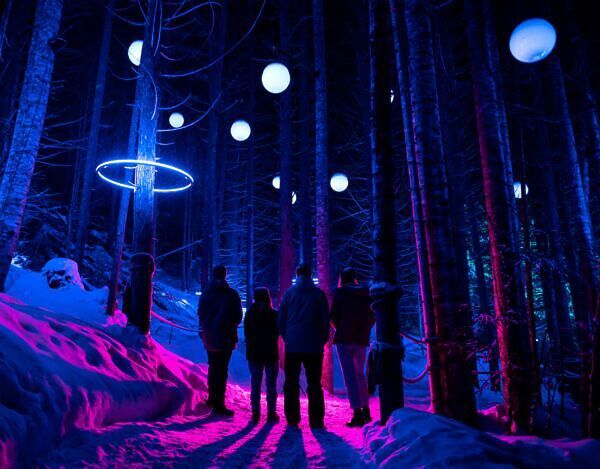Night Walks with UV Light: Discover nocturnal wonders on a UV light night walk

Can you imagine the hidden beauty that comes alive under the cover of darkness? Night walks with UV light reveal an enchanting world often overlooked. This article delves into the nocturnal wonders unveiled during a UV light night walk, shedding light (quite literally) on the attractions you might find in your nighttime adventures.

What is a UV Light Night Walk?
A UV light night walk involves exploring nature after sunset using ultraviolet light. This unique experience invites participants to discover plants, animals, and minerals that fluoresce under UV light. Unlike traditional flashlight walks, UV lights reveal a hidden world teeming with vibrant colors and intriguing patterns, offering a fresh perspective on nocturnal exploration.
Typically, UV light night walks are conducted in natural settings like forests, desert landscapes, or coastal areas. Participants are armed with UV torches and often guided by experts who understand the best spots to uncover these hidden marvels. It provides a safe and engaging way to appreciate nature while also learning about the unique properties of certain elements that react to UV light.
The Science Behind UV Light Fluorescence

Fluorescence occurs when certain molecules absorb light at one wavelength and emit it at a longer wavelength. When UV light, which is invisible to the naked eye, strikes these molecules, they re-emit it as visible light. This stunning transformation can turn an ordinary walk into a kaleidoscope of glowing plants, insects, and minerals.
For instance, some minerals like calcite and fluorite glow brilliantly under UV light, showing colors ranging from neon green to a deep purple. Certain plants and fungi emit fascinating luminescence, and even some insects exhibit this phenomenon due to their unique body compositions. This fluorescence is not just a visual treat but also a window into the biochemical and structural properties of these organisms.
Preparing for Your UV Light Night Walk
Embarking on a UV light night walk requires some preparation to ensure you get the most out of the experience. Here are a few tips:
- Get a Good UV Torch: Invest in a quality UV torch with a wavelength of about 365 nm for the best results.
- Wear Appropriate Clothing: Dress warmly and wear rugged shoes suitable for nighttime terrain.
- Bring Safety Gear: Don’t forget items like bug repellent, a first aid kit, and extra batteries for your torch.
- Research Locations: Find out areas known for their fluorescent plants, minerals, or wildlife.
- Go with a Guide: If you’re new to this, consider joining a guided tour to learn and explore safely.
Extraordinary Sights on a UV Light Night Walk
The sights you’ll encounter on a UV light night walk can be quite extraordinary. For example, scorpions are famously known to glow blue-green under UV light due to substances found in their exoskeletons. This can be both thrilling and educational, as it provides insights into their survival strategies.
Additionally, certain flowers, such as some species of daisies and primroses, glow under UV light. These fluorescences, which may not be apparent during the day, make the plants a visual spectacle in the dark. Lichens and fungi often show surprising levels of fluorescence, turning a simple walk through the woods into a vibrant journey of discovery.

Educational and Ecological Benefits
Night walks with UV light do more than just entertain; they educate and foster a deeper appreciation for the complexity of the natural world. Participants often learn about the unique characteristics of fluorescent organisms and the ecological roles they play. It bridges a connection to nature that is otherwise missed during daylight adventures.

From an ecological standpoint, understanding which species exhibit fluorescence can contribute to biodiversity studies and monitoring. For example, researchers can track population distributions, environmental changes, and even identify new species through UV light exploration. This type of engagement promotes conservation efforts and habitats’ preservation, enhancing our understanding of the world’s nocturnal beauty.
Conclusion
Night walks with UV light offer a fascinating way to uncover the otherwise hidden wonders of the natural world. As you explore fluorescent organisms and materials, you’ll gain a new appreciation for the intricate beauty that surrounds us, unseen in the daylight. Whether you’re a nature enthusiast, a science buff, or someone looking for a unique adventure, a UV light night walk provides an educational and thrilling experience.
FAQs
What makes certain organisms fluoresce under UV light?
Fluorescence occurs when molecules in an organism absorb UV light and re-emit it as visible light. This typically happens because of specific proteins, minerals, or compounds within the organism that have fluorescent properties.
Is UV light harmful during night walks?
While brief exposure to UV light is generally safe, it’s essential to use UV torches designed for such walks and follow safety guidelines, such as not shining the light directly into the eyes of people or animals.
Can I see UV fluorescence with the naked eye?
You cannot see UV light itself with the naked eye, but you can see the fluorescence that occurs when UV light interacts with certain objects or organisms, making them glow in visible colors.
Do I need special equipment for a UV light night walk?
Yes, a UV torch with the appropriate wavelength (around 365 nm) is necessary to see the full range of fluorescent phenomena. Additionally, wearing protective gear and being prepared for outdoor conditions is advisable.
Where can I find guided UV light night walks?
Many national parks, nature reserves, and adventure tour companies offer guided UV light night walks. Researching online or contacting local nature centers can provide information on available tours.